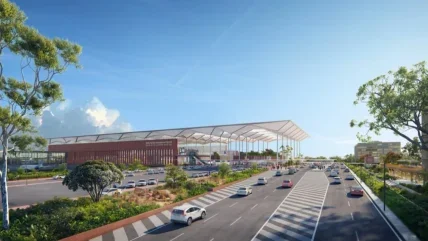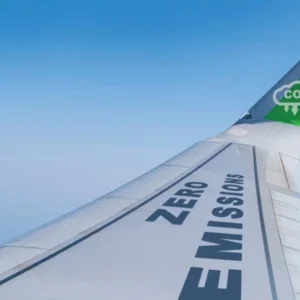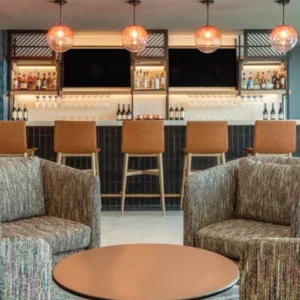
In November 2021, in the fields southeast of Delhi, Narendra Modi took part in a special event. Flanked by a crowd of mask-wearing officials, he laid the foundation stone at the Noida International Airport, a new project due to welcome passengers by 2024. Naturally, these kinds of photo opportunities are hardly unusual for a savvy prime minister. But as a devout Hindu, Modi also gave the ceremony a sprinkle of religiosity. With a crowd looking on, he took part in the ‘bhoomi pujan’ – a ritual aimed at securing divine blessing for a scheme and ensuring construction runs smoothly.
The more you learn about Noida, the more appropriate the bhoomi pujan starts to feel. In its architecture and philosophy, after all, this is a uniquely Indian airport, one that carefully exploits ancient traditions to offer passengers something new. And just as the bhoomi pujan is performed to honour the ground a structure is built on – ‘bhoomi’ means ‘Mother Earth’ in Sanskrit – so too will Noida be conscious of the land around it. From in-house recycling to a sustainable fuel centre, this promises to be an airport that keeps the paddies of Uttar Pradesh as pristine as can be expected for a site that’ll eventually handle 70 million passengers each year.
Not, of course, that any of this is easy. In an industry accustomed to airports framed by steel and glass, integrating vernacular aesthetics into Noida requires both a thoughtful eye and elegant planning. That’s doubly true given Noida International’s strikingly global design team. Drawing in experts from as far afield as England and Norway, forced to collaborate in the midst of a pandemic, Noida is surely one of the world’s first Zoom airports. Be that as it may, this is a place that could soon have very real consequences for design in the physical world too – and not just on the edge of the Indian capital.
Leaning into green
Even decades after independence, air travel was largely unknown in India. Between a comprehensive railway network, limited foreign tourism and grinding rural poverty, a mere 2.6 million passengers flew here as late as 1970. But with the Indian economy exploding since the turn of the millennium, that number has soared. Just before the pandemic, in 2019, Indian airports carried nearly 170 million people, a figure the Indian government has said could reach 855 million by the middle of the next decade.
This demand, in itself, begins to explain the thinking behind Noida International. The airport’s location matters too. About a 90 minute drive from the frantic heart of New Delhi, the site will be ideally located to service the city’s ballooning suburbs, breezeblock and concrete satellite towns like Faridabad and Ballabhgarh. Combined with easy access to tourist centres like the Taj Mahal – and the rise of cheap domestic airlines like Akasa – and it’s easy to say why executives like Christoph Schnellmann are so excited. As the airport’s CEO puts it: “Noida has so much potential with wonderful investments and growth opportunities for investors looking to capitalise on the rising Indian economy.”
To an extent, then, Noida International fits snugly into India’s broader economic miracle. But examine the details and it soon becomes clear that the airport is also startlingly different from the belching factories that often characterise the subcontinent’s developmental model.
“Noida has so much potential with wonderful investments and growth opportunities for investors looking to capitalise on the rising Indian economy.”
Christoph Schnellmann
That’s clear enough when you start examining Noida’s environmental features. Promising a sustainable fuel farm, visiting aircraft will be able to load up via several large tanks. Connected via an underground hydrant network, the system will be flexible enough to increase capacity for sudden arrivals. At the same time, Noida’s designers are putting great stock in recycling.
2.6 million
Passenger numbers for all of India in 1970.
170 million
Passenger numbers in 2019, before the Covid-19 pandemic.
International Civil Aviation Organisation
A waste management facility will allow officials to segregate and recycle plastic and glass, while a water conservation scheme is in the offing too.
All this is possible, argues Klaus Bode, because Noida is being built on a greenfield site. Unlike many examples in crowded Western countries, which essentially involve tinkering with existing sites, the director at Urban Systems Design – a London practice involved in the Noida project – explains that the architects in this case have been given carte blanche. As Bode continues, that allows them to weave environmentalism right into the design. “The infrastructure is not so well developed,” he says. “So, they’re able to build more sustainable airports than other parts of the world where you’ve still got existing airports.”
Fair enough: barely a year has passed since the prime minister’s trip and Noida International is already parading its green credentials. Nordic, an Oslo-based architecture firm involved in the construction, suggests Noida could enjoy LEED Gold standard certification, while managers hope the airport will be a net-zero operation.
Building back better
Even before it’s finished, in short, Noida International is already being touted as India’s greenest airport – and given the sustainable shopping list it’s hard to disagree. However, what really makes the scheme special is something more fundamental: its architecture. That’s obvious enough if you glance at mock-ups posted online, with their open columns and flowing lines. But on an even deeper level, Bode says that inspiration for the terminal comes from traditional Indian architecture, explaining how the design team borrowed much from local vernacular buildings. “You do a variety of spaces,” Bode says, “and not these homogenous monocultural environments.”
In practice, the way Noida will welcome passengers feels anything but homogeneous. Consider, for instance, the terminal entrance. At Indian airports, travellers have to pass through a security checkpoint before they can check in their bags. Given the number of passengers Noida plans to take – executives hope to accommodate 12 million a year as early as 2024 – building a regular drop-off area could soon cause chaos. Instead taking a cue from traditional Indian courtyards, Bode and his colleagues envisage a generous forecourt outside the terminal building, giving people somewhere comfortable to wait. Shielded from the blazing Indian heat by canopies and movable barriers that can follow the sun, they even hope to give the space a unique microclimate, keeping people cool even when Uttar Pradesh thermometers hit a July average of 34°C.
Nor is this the only area where the designers are thinking intelligently about local culture when drawing up their blueprints. Once they’re actually inside the airport, guests will be able to enjoy an internal courtyard, inspired by traditional mansions called ‘havelis’ and offering interiors plenty of l ight and fresh air. Bode hopes that duty free shops could even transfer their custom outside during cooler times of the year, giving the whole space the atmosphere of an Indian market. Schnellmann makes a similar point, describing how the airport’s roof is designed to echo the region’s many streams and rivers. The aim, at any rate, is to promote what Bode calls the “rehumanisation” of air travel – something he equally argues can help airport operators make money, as guests feel relaxed and may even buy a souvenir of their experience.
And if all these innovations promise to bolster the passenger experience, Schnellmann is similarly keen to emphasise the environmental factors at play here. “At the airport’s terminal,” he says, “passive measures such as the use of natural lighting, natural ventilation, and glare protection will be planned, which will help improve passenger experience and reduce CO2 footprint and energy costs.” A fair point: all those microclimates and courtyards drastically cut the need for both air-conditioning and light bulbs, a boon for any airport eager for a nod from LEED. That’s shadowed, too, by a comprehensive landscaping system, encompassing the planting of trees and flowers, which Schnellmann says will serve as the “lungs” for the whole 5,000-hectare site.
An international achievement
Together with a plethora of digital goodies – staff will embrace paperless work even as passengers are promised hassle-free biometric checkpoints – and it’s easy to see why so many are excited about Noida. Aside from Narendra Modi’s visit, Indian politicians have queued up to praise it, while Uttar Pradesh’s chief minister has committed to building a skill development centre on land near the terminal. In a sense, just getting to this point is an achievement. As Bode and Schnellmann both admit, the international nature of the airport’s design – to say nothing of the travel restrictions imposed by Covid – meant that in-person development meetings were quickly replaced by vast communal Zoom sessions. In the end, however, everyone adapted to this new online reality, with Bode noting that most modern architectural plans are coded in ones and zeros anyway.
Now, moreover, there are specific incentives to stay on course, with the local government threatening to slap a daily fine equivalent to over $12,000 in the event of any delay. Apart from the pain that lateness could cause the airport’s accountants, you have to hope that Noida International does indeed open soon.
70 million
The number of passengers each year that will eventually pass through Noida International Airport.
Noida International Airport
“The infrastructure is not so well developed. So they’re able to build more sustainable airports than other parts of the world where you’ve still got existing airports.”
Klaus Bode
Attempting to drag the passenger experience away from the soulless and generic motifs the industry’s become accustomed to, Bode hopes that what’s achieved here could yet influence airports the world over. “I would love it,” he says, adding that wherever a project is found, it only needs designers who are “sympathetic to architecture and not slaves to architecture”. That’s certainly true at Noida – even if a bhoomi pujan may not be appropriate everywhere.






